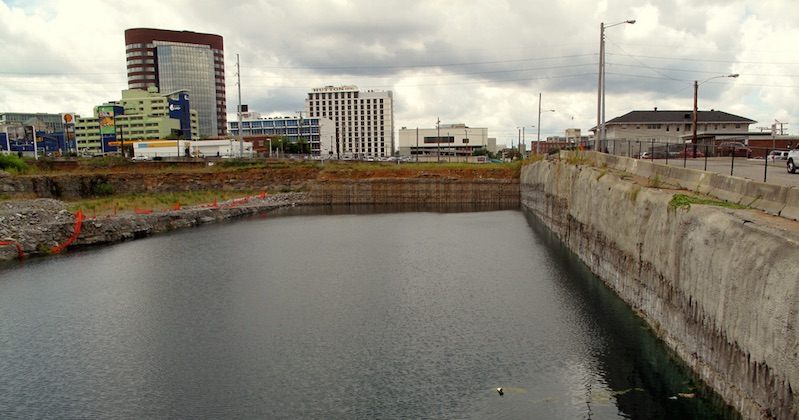Lake Palmer: Nashville’s Accidental Lake

Lake Palmer, in all its glory, circa 2009 (Photo: David Antis/Flickr)
Officially, Lake Palmer does not exist. And it’s only one of many unnatural bodies of water around Nashville, Tennessee.
Lake Palmer is not a lake, and it is not named Lake Palmer. It is a hole in the ground, made in 2007, in the limestone that undergirds the city. It was supposed to be filled in by a mixed-use development. But nothing has ever been built on the site and, instead, the hole—which looks to span two or three acres—has been filled by rain, creating a body of water that at times has reached depths of maybe 50 to 60 feet deep.
Locals named it Lake Palmer, after Alex Palmer, the developer whose development never materialized, and it has been around so long that, as the Nashville Scene recently reported, Google Maps now recognizes that there is a water feature there (albeit an unnamed one).
It’s starting to seem like Lake Palmer might be a permanent feature of Nashville’s downtown.

(c) 2015 Google - Map Data
“The first thing to remember here is that it’s almost literally in the middle of town,” says J.R. Lind, a Nashville reporter who’s covered the lake over the years. “It looks like a quarry, because it’s all limestone. It’s been about eight years since they broke ground, and all that was ever done was make an 80 foot hole in the middle of the city.”
Nashville’s actually quite used to unnatural lakes. It’s in a river basin—the Cumberland River runs right through the city’s center—but the lakes around town are man-made. Old Hickory Lake, which USA TODAY reports is “one of the state’s best fishing spots,” is a reservoir created by the Army Corps of Engineers. J. Percy Priest Lake, Cheatham Lake, and Center Hill Lake—all also created by the Corps. All in all, the Corps has created 10 lakes in the Nashville district. Even Radnor Lake, located in a natural area within the city limits, was created by a railroad company in 1914.
But, unlike those lakes, Lake Palmer wasn’t planned—it just happened. Originally, Palmer, the developer, had planned for two 25-foot towers, that would hold offices, retails, condos, and a hotel. By 2008, though, pretty much the only thing accomplished was “the digging of the hole in the ground,” the Nashville Post reported. After that, the project was in limbo, until in 2012, the health care company HCA started planning to build headquarters for two of its subsidiary parts on the site. That fell through. Just this January, a new plan, to build an apartment complex, was in the works—but so far, nothing at the site has changed.
In the meantime, locals aren’t necessarily getting to enjoy the pleasures of a downtown lakeside. The site’s surrounded by a high fence and, Lind says, he’s never heard of anyone trespassing (or seen any incidents in the police reports he regularly checks). In 2010, though, after a big flood meant water restrictions for city, public swimming pools and country clubs sent tanker trucks to suck up water from the lake to fill their own needs. “That’s the only public function it ever served,” says Lind.
Mostly, it’s just an oddity—a point of public interest that crops up from time to time, or a worry when it gets hot and muggy and the lake starts to look like a particularly appealing breeding ground for mosquitos. “It’s just something that we sort of shrug our shoulder at, and we deal with,” says Lind. “The construction has stalled again, and we’re entering our wet season. So I guess it’ll just fill up.”
Maybe one day Lake Palmer will disappear, and the original intention for the site—to have a building there—will finally be fulfilled. Or perhaps Lake Palmer will linger—long enough that Google even learns its name.

Image capture July 2011 (c) 2015 Google



Follow us on Twitter to get the latest on the world's hidden wonders.
Like us on Facebook to get the latest on the world's hidden wonders.
Follow us on Twitter Like us on Facebook